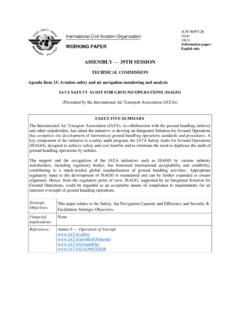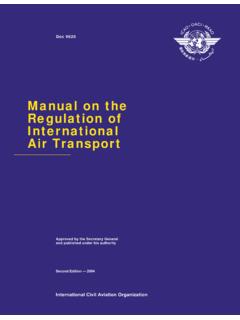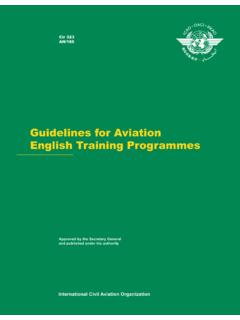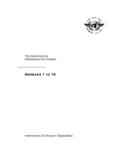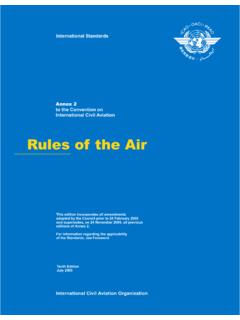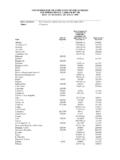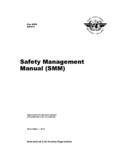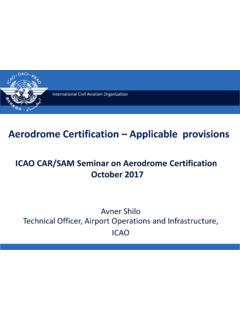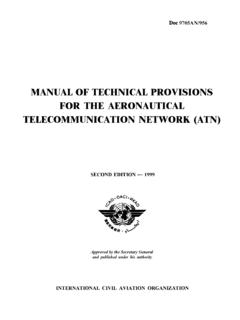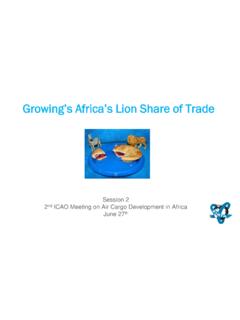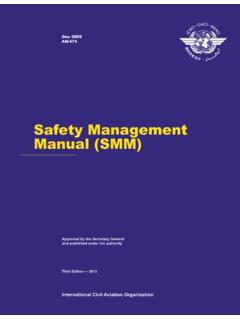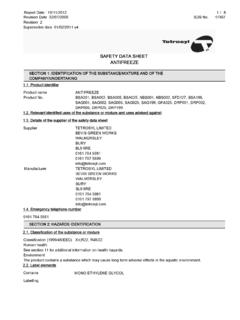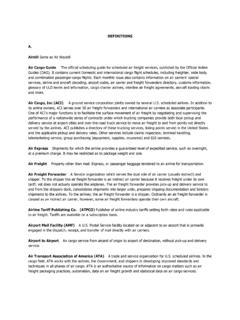Transcription of Doc 9303 Machine Readable Travel Documents - ICAO
1 Approved by and published under the authority of the Secretary GeneralINTERNATIONAL CIVIL AVIATION ORGANIZATIONDoc 9303 Machine Readable Travel DocumentsPart 1: IntroductionEighth Edition, 2021 Approved by and published under the authority of the Secretary GeneralINTERNATIONAL CIVIL AVIATION ORGANIZATIONDoc 9303 Machine Readable Travel DocumentsPart 1: IntroductionEighth Edition, 2021 Published in separate English, Arabic, Chinese, French, Russian And Spanish editions by the international CIVIL AVIATION ORGANIZATION 999 Robert-Bourassa Boulevard, Montr al, Qu bec, Canada H3C 5H7 Downloads and additional information are available at Doc 9303, Machine Readable Travel Documents Part 1 Introduction ISBN 978-92-9265-291-3 ICAO 2021 All rights reserved. No part of this publication may be reproduced, stored in a Retrieval system or transmitted in any form or by any means, without prior Permission in writing from the international Civil Aviation Organization.
2 (iii) AMENDMENTS Amendments are announced in the supplements to the Products and Services Catalogue; the Catalogue and its supplements are available on the ICAO website at The space below is provided to keep a record of such amendments. RECORD OF AMENDMENTS AND CORRIGENDA AMENDMENTS CORRIGENDA No. Date Entered by No. Date Entered by The designations employed and the presentation of the material in this publication do not imply the expression of any opinion whatsoever on the part of ICAO concerning the legal status of any country, territory, city or area or of its authorities, or concerning the delimitation of its frontiers or boundaries. (v) TABLE OF CONTENTS Page 1.
3 FOREWORD .. 1 2. SCOPE .. 1 3. GENERAL CONSIDERATIONS .. 2 ICAO s Leadership Role .. 2 Relative Costs and Benefits of Machine Readable Travel Documents .. 2 Operations .. 3 Endorsement by ISO .. 3 4. DEFINITIONS AND REFERENCES .. 4 Acronyms .. 4 Terms and Definitions .. 8 Key Words .. 25 Object Identifiers .. 26 The Use of Notes .. 29 5. GUIDANCE ON THE USE OF DOC 9303 .. 29 Doc 9303 Composition .. 29 Relationship between MRTD Form Factors and relevant Doc 9303 Parts .. 31 6. REFERENCES (NORMATIVE) .. 31 _____ 1 1.
4 FOREWORD ICAO s work on Machine Readable Travel Documents began in 1968 with the establishment, by the Air transport Committee of the Council, of a Panel on Passport Cards. This Panel was charged with developing recommendations for a standardized passport book or card that would be Machine Readable , in the interest of accelerating the clearance of passengers through passport controls. The Panel produced a number of recommendations, including the adoption of optical character recognition (OCR) as the Machine reading technology of choice due to its maturity, cost-effectiveness and reliability. In 1980, the specifications and guidance material developed by the Panel were published as the first edition of Doc 9303, titled A Passport with Machine Readable Capability, which became the basis for the initial issuance of Machine Readable passports by Australia, Canada and the United States.
5 In 1984, ICAO established what is now known as the Technical Advisory Group on Machine Readable Travel Documents (TAG/MRTD), comprised of government officials who specialize in the issuance and border inspection of passports and other Travel Documents , in order to update and enhance the specifications which had been prepared by the Panel. Subsequently, this group s terms of reference were expanded to include, first, the development of specifications for a Machine Readable visa and, later, specifications for Machine Readable cards that may be used as official Travel Documents . In 1998, the New Technologies Working Group of the TAG/MRTD began work to establish the most effective biometric identification system and associated means of data storage for use in MRTD applications, particularly in relation to document issuance and immigration considerations.
6 The bulk of the work had been completed by the time the events of 11 September 2001 caused States to attach greater importance to the security of a Travel document and the identification of its holder. The work was quickly finalized and endorsed by the TAG/MRTD and the Air transport Committee. The resulting Technical Reports on the employment of biometrics and contactless chip technology, Logical Data Structure (LDS), and Public Key Infrastructure (PKI) were incorporated into Volume 2 of the Sixth Edition of Doc 9303, Part 1 ( Machine Readable Passports) in 2006, and Volume 2 of the Third Edition of Doc 9303, Part 3 ( Machine Readable Official Travel Documents ) in 2008. 2. SCOPE Doc 9303 consists of various separate Documents in which general (applicable to all MRTDs) as well as MRTD form factor specific specifications are grouped.
7 See Section Doc 9303 Composition for an overview. These specifications are not intended to be a standard for national identity Documents . However, a State whose identity Documents are recognized by other States as valid Travel Documents shall design its identity Documents such that they conform to the specifications of Doc 9303-3 and Doc 9303-4, Doc 9303-5 or Doc 9303-6. Although the specifications in Doc 9303-4 are intended for particular application to the passport, these specifications apply equally to other TD3 size identity Documents , for example, the laissez-passer, the seafarer s identity document and refugee Travel Documents . 2 Machine Readable Travel Documents The document at hand is Part 1. Part 1 introduces the Doc 9303 specifications. It describes the build-up of the thirteen parts of Doc 9303, provides general information on ICAO, and guidance on the terminology and abbreviations used throughout the specifications.
8 3. GENERAL CONSIDERATIONS ICAO s Leadership Role ICAO s initiative to develop standard specifications for passports and other Travel Documents followed the tradition established by the League of Nations Passport Conferences of the 1920s and the work of the League s successor, the United Nations Organization. ICAO s mandate to continue in its leadership role stems from the Convention on international Civil Aviation (the Chicago Convention ) which covers the full range of requirements for efficient and orderly civil aviation operations, including provisions for clearance of persons through border controls, : a) the requirement for persons travelling by air and aircraft crews to comply with immigration, customs and passport regulations (Article 13); b) the requirement for States to facilitate border clearance formalities and prevent unnecessary delays (Article 22); c) the requirement that States collaborate in these matters (Article 23); and d) the requirement for States to develop and adopt internationally standard procedures for immigration and customs clearance (Article 37 j)).
9 Under this mandate, ICAO develops and maintains international Standards in Annex 9 Facilitation to the Chicago Convention for implementation by Member States. In the development of such Standards, it is a fundamental precept that if public authorities are to facilitate inspection formalities for the vast majority of air travellers, those authorities must have a satisfactory level of confidence in the reliability of Travel Documents and in the effectiveness of inspection procedures. The production of standardized specifications for Travel Documents and the data contained therein is aimed at building that confidence. In 2004, the Assembly of ICAO affirmed that cooperative work on specifications to strengthen the security and integrity of Travel Documents should be pursued by the Organization as a matter of high priority.
10 In addition to the international Organization for Standardization (ISO), consultants to the TAG/MRTD include the international Air transport association ( iata ), the Airports Council international (ACI), and the international Criminal Police Organization (INTERPOL). In 2005, the then 188 Member States of ICAO approved a new Standard that all States must begin issuing Machine Readable passports in accordance with Doc 9303 no later than the year 2010. No later than the year 2015 all non- Machine Readable Travel Documents must have expired. This Standard is published in the 13th Edition (2011) of Annex 9 Facilitation. Relative Costs and Benefits of Machine Readable Travel Documents Experience with the issuance of Machine Readable passports, in conformity with the specifications set forth in Doc 9303, indicates that the cost of producing MRTDs may be no greater than that of producing conventional Documents , though the cost will be higher when biometric identification and electronic Travel Documents are implemented.
